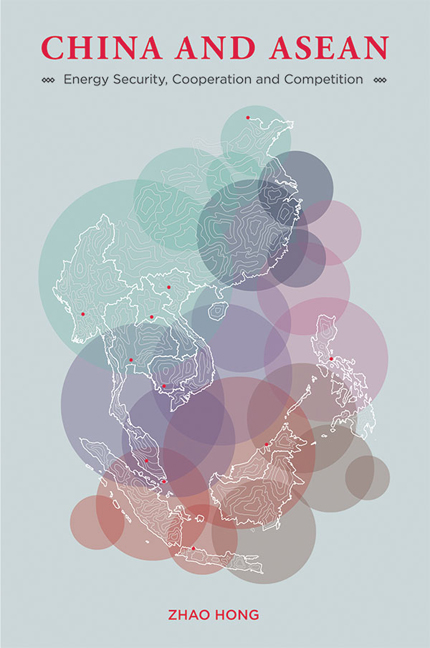Book contents
- Frontmatter
- Contents
- List of Tables and Figures
- List of Abbreviations
- Acknowledgements
- 1 Introduction: China, ASEAN, and the New Global Energy Order
- 2 Economic Growth and Energy Security
- 3 China's Energy Quest in Southeast Asia
- 4 Case Study (1): Myanmar
- 5 Case Study (2): Indonesia
- 6 Energy Resource Competition and the South China Sea Disputes
- 7 Conclusion
- Index
- About the Author
1 - Introduction: China, ASEAN, and the New Global Energy Order
Published online by Cambridge University Press: 19 May 2017
- Frontmatter
- Contents
- List of Tables and Figures
- List of Abbreviations
- Acknowledgements
- 1 Introduction: China, ASEAN, and the New Global Energy Order
- 2 Economic Growth and Energy Security
- 3 China's Energy Quest in Southeast Asia
- 4 Case Study (1): Myanmar
- 5 Case Study (2): Indonesia
- 6 Energy Resource Competition and the South China Sea Disputes
- 7 Conclusion
- Index
- About the Author
Summary
CHINA'S RISE AND SOUTHEAST ASIA
This book has been motivated largely by the rapid rise of China and its consequent influence in the world, particularly in Southeast Asia. As an emerging power in East Asia, China is the main driver behind the geopolitical and economic reconfiguration that is taking place in Asia. Southeast Asia is one of the areas that is affected most directly by the rise of China. On the other hand, interactions between China and ASEAN (Association of Southeast Asian Nations) will, to a great extent, affect the future and prospect of the entire Asia, leading East Asia to become the world's new economic centre of gravity, and affect the world economic and energy map.
In East Asia, few relations have evolved as much as that between China and ASEAN. The threat of China looms large in the history of the relations between China and Southeast Asian countries. In particular, Chinese support for local communist groups during the 1960s and its views of ASEAN as an anti-Chinese, anti-communist alliance created distrust and frictions in China–ASEAN relations. China's siding with ASEAN during Vietnam's occupation of Cambodia contributed to re-establishing relations with Thailand, Malaysia, and the Philippines, but those between China and Brunei, Indonesia, and Singapore were not restored until 1990–91. Mutual suspicion lingered through much of the 1990s, due to memories of its support for communist insurgencies and the Chinese tendency to dismiss these smaller countries as puppets of U.S. imperialism.
The end of the Cold War was a pivotal turning point in China–ASEAN relations. ASEAN and China began to perceive complementary advantages in closer cooperation. Southeast Asia had energy resources which China did not have; China was modernizing rapidly and could contribute to modernization in Southeast Asia. China embarked on a new policy that was more geared toward the East, with Southeast Asia as a major focus. China's “good neighbour policy” was aimed at strengthening regional relations so as to surround itself with benevolent states, which would allow China to focus on its economic development.
- Type
- Chapter
- Information
- China and ASEANEnergy Security, Cooperation and Competition, pp. 1 - 23Publisher: ISEAS–Yusof Ishak InstitutePrint publication year: 2015



